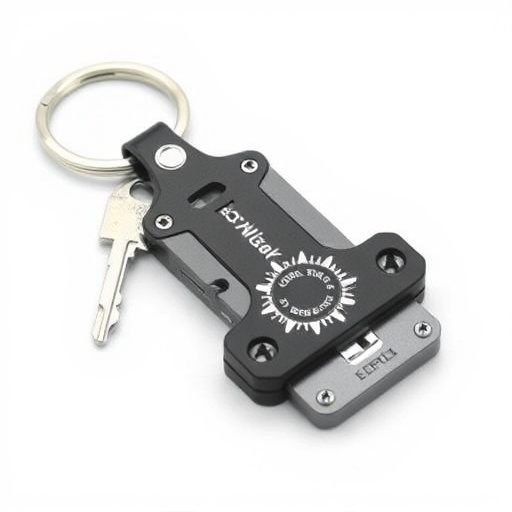The legality of non-lethal keychain weapons varies globally, governed by complex national and local laws. Users and manufacturers must stay informed about these regulations, which dictate sale, possession, and use, emphasizing public safety. These weapons are allowed under specific conditions, like self-defense against imminent threats, with requirements including design limitations, safety mechanisms, age restrictions, and registration. Regular checks on official sources and industry news ensure compliance and safe ownership of devices like pepper spray or tasers.
- Understanding Non-Lethal Keychain Weapons: A Legal Perspective
- Regional and National Legal Frameworks for Keychain Safety Devices
- What Makes a Keychain Weapon 'Legal'? Essential Features and Compliance
- Staying Informed: Keeping Up with Changes in Keychain Device Regulations
Understanding Non-Lethal Keychain Weapons: A Legal Perspective
Non-lethal keychain weapons, often marketed as self-defense tools, have gained popularity due to their compact size and accessibility. However, understanding the legal requirements surrounding these devices is crucial for both consumers and law enforcement. The legality of non-lethal keychain weapons varies significantly across jurisdictions, with some regions allowing them outright while others restrict or prohibit their use.
From a legal perspective, the classification of these devices as “non-lethal” implies they should cause minimal harm and not be deadly. Many countries have specific regulations that categorize and govern the sale, possession, and use of personal defense tools, ensuring public safety while allowing individuals to protect themselves. When considering whether non-lethal keychain weapons are allowed, it’s essential to check local laws, as well as any restrictions or permits required for their possession and use in public spaces.
Regional and National Legal Frameworks for Keychain Safety Devices
In many regions, the legal status of non-lethal keychain weapons is governed by a complex interplay of national and local laws. These frameworks vary significantly across countries and even within states or provinces, making it crucial for manufacturers, distributors, and owners to conduct thorough research. For instance, while some nations explicitly prohibit any form of personal defense device, others allow specific types under certain conditions, such as self-defense against an imminent threat.
Understanding these legal landscapes is essential when considering the distribution and use of non-lethal keychain weapons. Key factors include the definition of a weapon in local laws, restrictions on carrying concealed items, and requirements for obtaining permits or licenses. For example, some regions might differentiate between objects designed primarily for self-defense and those considered offensive weapons, with distinct legal implications. Staying informed about these regulations is vital to ensure compliance and mitigate potential legal consequences.
What Makes a Keychain Weapon 'Legal'? Essential Features and Compliance
When it comes to legality, non-lethal keychain weapons must adhere to specific guidelines and features to be considered legal in many jurisdictions. The primary factor is their design; these weapons are intended for self-defense and should not cause serious harm or permanent disability. They are designed to incapacitate temporarily, not to kill or cause lasting injury. Features like a safety lock mechanism, automatic shut-off after deployment, and a limited range are essential to meet legal standards.
Compliance also involves meeting certain criteria set by local laws and regulations. These may include age restrictions on ownership, specific registration requirements, and limitations on where and how the device can be used or carried. Understanding these legal aspects is crucial for anyone considering owning a non-lethal keychain weapon to ensure they stay within the boundaries of the law and are fully aware of their responsibilities as a user.
Staying Informed: Keeping Up with Changes in Keychain Device Regulations
Staying informed about the latest keychain device regulations is crucial for both users and manufacturers. The legal landscape surrounding non-lethal keychain weapons, such as pepper spray or tasers, is constantly evolving. Changes in legislation can impact which devices are allowed, where they can be carried, and who can possess them. Keeping up with these updates ensures that you’re compliant with the law and can make informed decisions when choosing a self-defense tool.
Regularly checking official government websites, industry news, and legal blogs is an effective way to stay ahead of the curve. Manufacturers must also register their products with relevant authorities to ensure they meet safety standards and comply with any restrictions on sale and possession. Users should be aware of these regulations to avoid legal repercussions and to guarantee their safety and the safety of others.
When it comes to non-lethal keychain weapons, understanding legal requirements is paramount. Different regions have varying regulations, so knowing what makes a keychain device ‘legal’ and staying informed about any changes in guidelines is crucial for responsible ownership. By adhering to these key aspects, users can ensure their right to carry personal defense tools while navigating the complexities of regional and national legal frameworks. Remember, compliance with these laws not only protects individuals but also fosters public safety and peace of mind.
